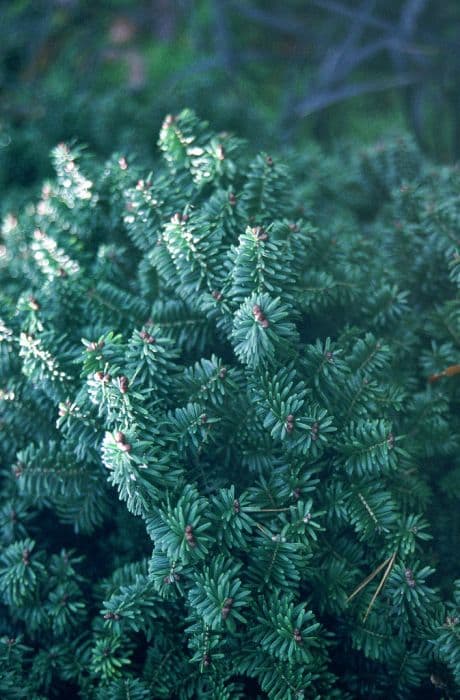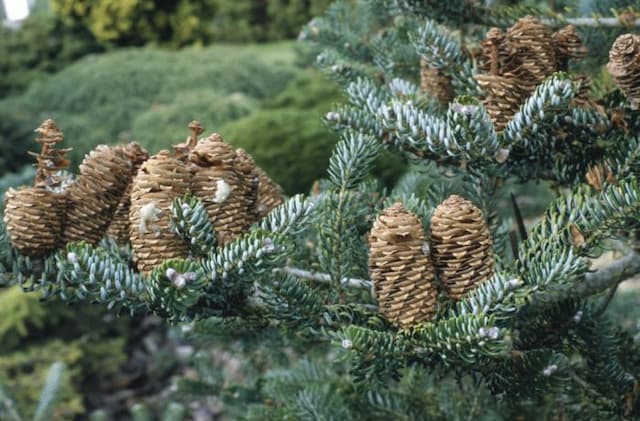Bhutan Pine Pinus wallichiana

ABOUT
The plant commonly known as the Himalayan pine features slender, flexible branches with a graceful, pendulous quality. It flaunts long, narrow needles that range from a bluish-green to a silver-green color, creating a soft, slightly shimmering effect in the light. These needles are grouped in fascicles, giving the appearance of lush tufts along the branches. The Himalayan pine's bark is an appealing reddish-brown, textured with deep fissures and attractive flaking patterns that add a rugged aspect to the tree's overall visual presence. This bark provides a striking contrast to the delicate look of the needles. Adding to its unique look, the tree produces elongated cones that hang elegantly from the branches. These cones start off with a greenish hue that matures into a rich brown, often staying on the tree for several years before falling. Throughout the year, the Himalayan pine maintains its visual appeal with evergreen foliage that provides a continuous display of color and texture. This makes the tree a valuable addition to landscapes, offering visual interest and a hint of the exotic due to its origins in the mountain ranges it is named after.
About this plant
 Names
NamesFamily
Pinaceae
Synonyms
Bhutan Pine, Blue Pine, Himalayan Pine, Himalayan White Pine, Blue Himalayan Pine, Griffin Pine
Common names
Pinus griffithii, Pinus chylla, Pinus excelsa, Pinus griffithiana.
 Toxicity
ToxicityTo humans
Pinus wallichiana, commonly known as the Himalayan pine, is not generally considered toxic to humans. There are no well-documented cases of poisoning from ingesting any part of this plant, and it is not known to contain any dangerous toxins that could cause serious harm if ingested. Therefore, eating parts of the Himalayan pine is unlikely to result in symptoms of poisoning.
To pets
Himalayan pine is not typically considered toxic to pets either. This plant does not contain known substances that are harmful to animals. However, consumption of needles might be irritating to the mouth or digestive tract of some pets, and could potentially cause mild gastrointestinal upset such as vomiting or diarrhea if ingested in large quantities. In general, it is always a good practice to monitor your pets and prevent them from eating large amounts of plant material, even those that are not known to be toxic.
 Characteristics
CharacteristicsLife cycle
Perennials
Foliage type
Evergreen
Color of leaves
Green
Height
50-80 feet (15-24 meters)
Spread
20-35 feet (6-11 meters)
Plant type
Tree
Hardiness zones
5-7
Native area
Himalayas
Benefits
 General Benefits
General Benefits- Erosion control: Pinus wallichiana, commonly known as the blue pine, has an extensive root system that can help stabilize soil and control erosion.
- Windbreak: Its height and dense growth make it an effective windbreak, which can protect smaller plants and reduce wind erosion.
- Habitat for wildlife: Blue pine forests provide essential habitat for a variety of wildlife, including birds and mammals.
- Aesthetic appeal: The tall stature and attractive blue-green foliage make it a popular ornamental tree in gardens and landscapes.
- Lumber production: The wood of blue pine is known for its strength and durability, making it useful for construction and carpentry.
- Climate resilience: Being a high-altitude species, it is adapted to cold climates and may be more resilient to the effects of climate change.
- Shade provision: The dense canopy can offer shade, making it a valuable addition to parks and outdoor recreational areas.
- Cultural significance: In some cultures, the blue pine has traditional significance and is used in rituals and ceremonies.
 Medical Properties
Medical Properties- Antioxidant - The extract from Pinus wallichiana needles has been shown to possess antioxidant properties, which can help in reducing oxidative stress within the body.
- Anti-inflammatory - The plant contains compounds that may exert anti-inflammatory effects, which can potentially reduce inflammation in various conditions.
- Analgesic - Some studies suggest the potential for analgesic properties, providing pain relief in certain ailments.
- Antimicrobial - Extracts from the plant have demonstrated antimicrobial activity, potentially offering a defense against certain bacteria and fungi.
- Antiseptic - The resin of Pinus wallichiana has historical uses in traditional medicine as an antiseptic for minor cuts and wounds.
 Air-purifying Qualities
Air-purifying QualitiesThis plant is not specifically known for air purifying qualities.
 Other Uses
Other Uses- Woodworking: Pinus wallichiana, commonly known as Bhutan pine, yields timber that is used for making boxes, crates, and interior woodwork.
- Resin Extraction: The resin tapped from the tree is used in the production of turpentine and other resinous products.
- Horticultural Use: The Bhutan pine is often planted as an ornamental tree in parks and large gardens for its attractive long needles and graceful habit.
- Windbreaks and Shelterbelts: Due to its height and density, the species is used in forestry plantings to provide wind protection for fields and crops.
- Erosion Control: Its extensive root system helps stabilize slopes and prevent soil erosion, particularly in mountainous regions.
- Christmas Trees: Bhutan pine is sometimes grown as a Christmas tree, favored for its pleasing form and aromatic needles.
- Disaster Mitigation: The trees are planted to mitigate the impact of landslides and avalanches in susceptible areas.
- Bonsai Culture: Enthusiasts may use the Bhutan pine for creating bonsai trees because of its aesthetic branches and foliage.
- Education and Research: The species is used in dendrology (the study of trees) as an example of high-altitude pine adaptations.
- Religious Significance: In some cultures, the Bhutan pine is associated with religious and spiritual practices, and it is used in sacred groves and rituals.
Interesting Facts
 Feng Shui
Feng ShuiThe Himalayan Blue Pine is not used in Feng Shui practice.
 Zodiac Sign Compitability
Zodiac Sign CompitabilityThe Himalayan Blue Pine is not used in astrology practice.
 Plant Symbolism
Plant Symbolism- Longevity: Pinus wallichiana, commonly known as Himalayan Pine, can live for a significant length of time, symbolizing a long life and persistence.
- Resilience: This pine species can survive in tough mountain climates, representing the ability to endure and withstand difficult conditions.
- Steadfastness: The sturdy nature of the Himalayan Pine stands for reliability and steadiness, much like its evergreen foliage that remains constant throughout the seasons.
- Serenity: The whisper of the wind through the needles of the Himalayan Pine is often seen as calming, evoking a sense of peace and tranquility.
- Wisdom: Trees are traditionally linked to wisdom, and the Himalayan Pine, with its stature and age, can be seen as a symbol of knowledge and contemplation.
 Water
WaterThe Himalayan Pine should be watered deeply every 2 to 3 weeks, depending on the climate conditions and soil drainage. Watering should involve slowly saturating the root zone with approximately 10 to 15 gallons for young trees each time, ensuring the water penetrates to a depth of 12 to 18 inches. During dry spells or in particularly hot weather, watering frequency should increase. It's important to avoid overwatering and ensure the soil has good drainage to prevent root rot. In winter, reduce watering as the tree’s water requirements decrease.
 Light
LightThe Himalayan Pine thrives best in full sunlight, where it can receive at least 6 hours of direct, unfiltered sunlight every day. It is a mountain species, so it is well adapted to bright conditions. The ideal spot for planting a Himalayan Pine would be an open area away from taller structures or trees that might create excessive shade.
 Temperature
TemperatureThe Himalayan Pine can endure a wide range of temperatures but grows best in areas where the temperature ranges from 20°F to 70°F. It can survive brief periods of colder winter temperatures down to about -10°F. The tree is hardy and adapted to mountainous climates, so it can tolerate cooler temperatures well but might not thrive in excessively hot climates.
 Pruning
PruningPruning the Himalayan Pine is generally done to maintain its shape and remove any damaged or diseased branches. It is best to prune in late winter or early spring before new growth begins. Prune sparingly, as pines do not regenerate foliage from old wood. Remove dead branches and those that cross over others to maintain structural integrity and allow light and air to reach the inner parts of the tree.
 Cleaning
CleaningNot needed
 Soil
SoilThe Himalayan Blue Pine prefers well-draining soil with a pH ranging from 5.5 to 6.5. An ideal soil mix can be created with equal parts of garden soil, peat moss, and perlite or sand to ensure good drainage.
 Repotting
RepottingThe Himalayan Blue Pine should be repotted every two to three years or when it becomes root-bound, doing so in spring before new growth begins for best results.
 Humidity & Misting
Humidity & MistingThe Himalayan Blue Pine thrives in moderate to high humidity but is quite adaptable and can tolerate lower humidity levels typically found in outdoor environments.
 Suitable locations
Suitable locationsIndoor
Ensure full sun, cool temperatures, and air movement.
Outdoor
Plant in full sun, well-drained soil, water deeply.
 Life cycle
Life cyclePinus wallichiana, commonly known as Bhutan pine or blue pine, begins its life cycle with seed germination, where seeds require stratification to break dormancy and then germinate best in moist, well-drained soil. Following germination, the seedlings grow through a juvenile phase characterized by a few primary needles and growth of the main taproot. As the sapling stage progresses, Bhutan pine develops its characteristic long, slender, and flexible needles in bundles of five and starts to form a conical crown. With maturation, the tree enters its reproductive phase, forming male and female cones; male cones produce pollen which is dispersed by wind to fertilize female cones. Once fertilized, the female cones take about two years to mature, after which they release seeds to start a new life cycle. Throughout its lifetime, which may extend to over 100 years, Bhutan pine undergoes periodic growth spurts and cone production, with older trees eventually reaching heights of up to 50 meters.
 Propogation
PropogationPropogation time
Spring to Summer
Propogation: The Bhutan pine, also known as Pinus wallichiana, is most commonly propagated through seeds. The optimal time for sowing its seeds is typically during the warm season or beginning of the growing season, which is usually late winter to spring. To propagate Bhutan pine, seeds should first be collected from cones that have naturally opened, indicating seed maturity. The seeds often benefit from a period of cold stratification to simulate winter conditions and break seed dormancy; this can be achieved by mixing the seeds with a moist substrate such as peat or sand and refrigerating for about 60-90 days. Following stratification, seeds are sown at a shallow depth in a well-draining seed starting mix. It's important to keep the soil moist but not waterlogged to prevent seed rot. Seedlings typically emerge within a few weeks to months, depending on conditions, and require protection from extreme elements until they are well established and ready for transplanting to their permanent location.









